SB visits… Jura
By Lauren BowesVisiting Islay is almost a rite of passage for Scotch whisky fans. We love to moan about the journey – the midges, the weather, the airport staff who told us off for some vague infraction – then smugly count how many of its 10 distilleries we’ve ticked off. But less common is a trip to Jura.
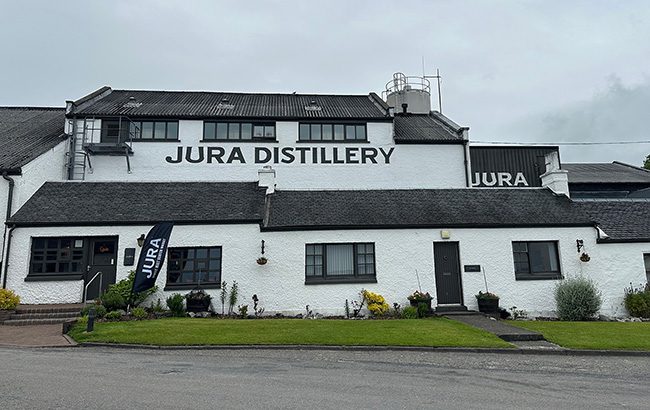
At just 142 square miles and home to fewer than 200 residents, Jura makes Islay’s population of 3,228 look like a metropolis. Despite being technically closer to the mainland, Jura has no airport, so everyone – and everything – arrives by boat. And unlike Islay, there are only three distilleries on the island – and only one makes Scotch.
It’s that Scotch distillery, which shares the island’s name, that took us to Jura last month. We were lucky enough to have a Venture West boat arranged for us, though most people will have to wait for the Jura passenger ferry, which only runs during peak season, and even then, not on Tuesdays, Wednesdays or Saturdays.
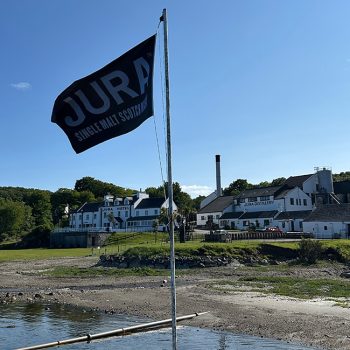
George Orwell wrote 1984 on Jura – a place he described as both ‘unforgettable’ and ‘ungetatable’. Alighting our boat at Tayvallich, it was the former description that seemed more apt, as we took in breathtaking views of the natural landscape before squealing over a family of sunbathing seals.
When your boat arrives at the island, you are immediately greeted by the Jura Distillery and the Jura Hotel. Considering much of the infrastructure of the island has been developed because of the distillery – which even had to widen roads to get its equipment in – you can forgive it for taking the prime spot.
For us, however, there was more of the island to explore before we could set eyes on those stills. Our first stop was a visit to the photography studio of Konrad Borkowski, who was already pouring out drams when we stepped in. And not just any drams. “It’s my whisky,” he laughed. “Though I didn’t make it.”
He wasn’t being precious – he was referring to the fact that the whisky was Jura Islanders’ Expressions No.3. The series is a range of limited edition whiskies inspired by different creative minds of the island – and the third release is based on Borkowski himself. The packaging features some of his photography, presented through a series of circles designed to mimic his camera lens.
Borkowski’s portfolio makes it clear why he was chosen. Though he’s travelled as far as Japan and frequently shoots on neighbouring Islay, some of his most stunning images are from Jura itself – including a twilight shot of a stag against a full moon that had some of our group planning 4.30am wake-ups.
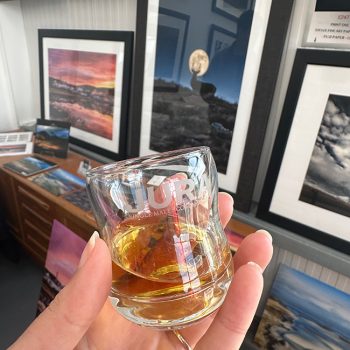
One of Borkowski’s books tucked under our arms, we headed to Jura Lodge. We had the owner of the local Antlers restaurant, Stuart Russell, as a personal chef for the evening. Russell certainly proved the quality of local produce and talent, as we enjoyed hand-dived scallops to start and venison loin for main. Hopefully not the same deer from Borkowski’s photo.
The history
Early the next morning, after breakfast at the Jura Hotel, we headed to the distillery for the visit we’d all been waiting for. The tour began with a history lesson from lead guide Fiona MacDonald.
Jura’s whisky-making dates to 1810, when it was home to the Small Isles Distillery, which was later renamed after the island. It changed hands frequently before James Ferguson took over in 1876 and invested heavily – building a pier, warehouses, workers’ cottages, and even a barley mill. The total cost was around £25,000 – nearly £3 million (US$4m) in today’s money.
Sadly, in 1901, Ferguson died, and his son wasn’t happy with the rental terms of the site. Thus, the distillery closed in 1913. It wasn’t until 1963 that whisky returned to Jura, thanks to Tony Riley-Smith and Robin Fletcher, who knocked down the old distillery and built a new one in its place. Their goal wasn’t just to make whisky – they also wanted to revive the island’s dwindling population, which had dropped from 1,300 people in the 1800s to less than 200.
The distillery
Inside the ‘new’ distillery, our tour began at the mash tun and the washbacks, where distillery manager Graeme Geddes explained that Jura needs to produce at least 2.1 million litres of spirit to meet demand – although its current capacity is up to 2.5m.
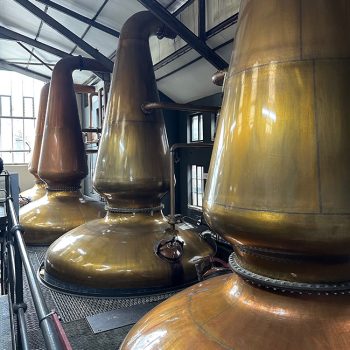
Fermentation times vary due to Jura’s natural water source: the Loch a’Bhaile Mhargaid. This means the water temperature is affected by the seasons, which could result in very different fermentation levels throughout the year. By lengthening or shortening the fermentation, Geddes and the team can keep the wash consistent, although the average fermentation time is around 60 hours.
There’s also occasion for inconsistency. Every year in September, the distillery closes to allow the team to attend the Jura Music Festival, during which, they leave the washbacks fermenting for 130 hours. “Hopefully there’ll be a Music Festival release in the future, where you’ve got that extra-long fermentation being used and adding to the fruitiness,” said Geddes.
Our next stop was the still room, home to Jura’s four stills. Like everything else, the stills had to arrive by boat, which is particularly impressive when you clock their size. “We chose the biggest still we could fit on the biggest boat,” said Geddes.
At 28 feet tall, they’re the largest stills of any island distillery – and among the biggest on the mainland, too. Geddes believes the vastness of the stills gives the whisky its signature fruity quality, as the liquid gets extra copper contact from its multiple rises and falls during distillation.
The whiskies
Distillery well and truly conquered, it was finally time to drink some whisky. Six expressions were lined in front of us, intended to give us a peek into Jura’s future releases.
The first, a future Perspectives release, will be presented without age statement, with its components ranging from eight to 19 years old – although the recipe remains a work in progress. “This has been created as our interpretation of the all-rounder,” explained blender Joe Ricketts. As well as varied ages, the liquid used was aged in different cask types, including first- and second-fill Bourbon casks and virgin oak. “You’ve got the freshness of the younger casks in there, but the richness and complexity of the slightly older casks, too.”
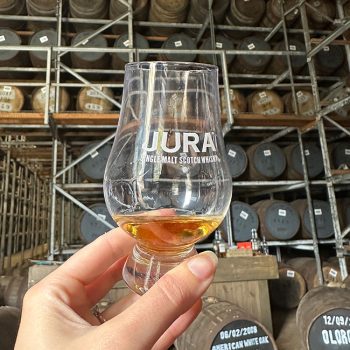
Next up are some of the work-in-progress components of Perspectives No.02. Our first sample was the Bourbon component, featuring a blend of whiskies aged in first-, second- and third-fill Bourbon casks that were laid down in 2010. The next is the same whisky that has finished in Amontillado butts.
“Fruity, aromatic and coastal are the key signifiers of the distillery character – here we’re looking to dial up the aromatic quality a little bit more,” said Ricketts. “We felt like the Amontillado was the right cask type for that. It’s going to be used in a sympathetic manner, so it doesn’t completely dominate the recipe – but it’s there to support the spirit character.”
The next dram was a true indication of the distillery’s style: a 1990 refill hogshead that has just launched as a distillery exclusive. Many of us are baffled by how much is created through such a simple cask type, with someone asking: “Where is that complexity coming from?”. “Jura’s spirit,” laughs Ricketts. “It’s literally just spirit and time, with very little cask influence.” Unlike some of Jura’s whiskies, which head to Invergordon for maturation, this expression was aged fully on the island.
Next up is a whisky that seems a little off-piste. The whisky was first laid down in 2001, but seven years ago, it was recasked into a Sauternes barrique. The distillery has just 20 barriques, so it’ll be a very limited release when it comes. “I came across [the barriques] about three years ago, and thought it was absolutely sensational,” explained Ricketts. There is no dissent to this statement, with many of us picking it as the highlight of the tasting, with its notes of apricot and peach and a hint of florality.
Our final sample is this year’s Fèis Ìle release, which was created as part of neighbouring Islay’s whisky festival. This is quite different from Jura’s house style, with the expression being laid down in 2007 and having a full maturation in oloroso Sherry butts. “It’s quite bold – probably the most robust of the bunch,” explains Ricketts.
One thing was notably absent during the tasting: peat. In the past, Jura used to use peated malt for a month each year, though Geddes explains the team haven’t done so since 2021. There are no plans to do it again, although there are still some peated stocks maturing, which may be used to give the new release a “smoky kiss”. “We’re wanting to stay focused on being light, fruity and balanced,” he said. ‘I think it’s caused confusion in the past,” he added, pointing to Islay’s reputation for peated malts.
As whisky tourism continues to grow, Jura offers something different: a sense of stillness. With just one Scotch distillery, no airport, and limited ferry access, it’s not the most accessible destination – but that’s exactly what makes it special. If you’ve ticked off Islay and want a new kind of island adventure, look east.
Related news
SB visits… Cocuy Saroche, Venezuela
